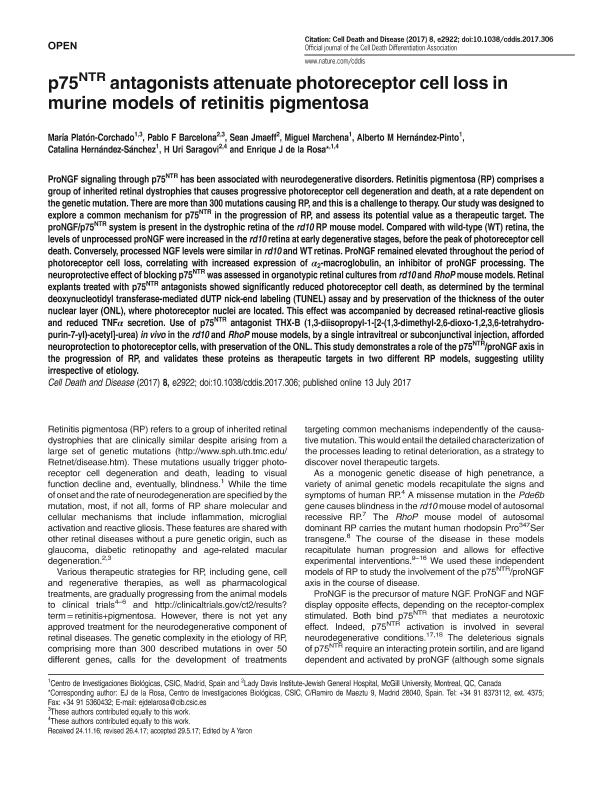Artículo
p75NTR antagonists attenuate photoreceptor cell loss in murine models of retinitis pigmentosa
Platón-Corchado, María; Barcelona, Pablo Federico ; Jmaeff, Sean; Marchena, Miguel; Hernández-Pinto, Alberto M.; Hernández-Sánchez, Catalina; Saragovi, H. Uri; de la Rosa, Enrique J
; Jmaeff, Sean; Marchena, Miguel; Hernández-Pinto, Alberto M.; Hernández-Sánchez, Catalina; Saragovi, H. Uri; de la Rosa, Enrique J
 ; Jmaeff, Sean; Marchena, Miguel; Hernández-Pinto, Alberto M.; Hernández-Sánchez, Catalina; Saragovi, H. Uri; de la Rosa, Enrique J
; Jmaeff, Sean; Marchena, Miguel; Hernández-Pinto, Alberto M.; Hernández-Sánchez, Catalina; Saragovi, H. Uri; de la Rosa, Enrique J
Fecha de publicación:
07/2017
Editorial:
Nature Publishing Group
Revista:
Cell Death and Disease
ISSN:
2041-4889
Idioma:
Inglés
Tipo de recurso:
Artículo publicado
Clasificación temática:
Resumen
ProNGF signaling through p75NTR has been associated with neurodegenerative disorders. Retinitis pigmentosa (RP) comprises a group of inherited retinal dystrophies that causes progressive photoreceptor cell degeneration and death, at a rate dependent on the genetic mutation. There are more than 300 mutations causing RP, and this is a challenge to therapy. Our study was designed to explore a common mechanism for p75NTR in the progression of RP, and assess its potential value as a therapeutic target. The proNGF/p75NTR system is present in the dystrophic retina of the rd10 RP mouse model. Compared with wild-type (WT) retina, the levels of unprocessed proNGF were increased in the rd10 retina at early degenerative stages, before the peak of photoreceptor cell death. Conversely, processed NGF levels were similar in rd10 and WT retinas. ProNGF remained elevated throughout the period of photoreceptor cell loss, correlating with increased expression of α2-macroglobulin, an inhibitor of proNGF processing. The neuroprotective effect of blocking p75NTR was assessed in organotypic retinal cultures from rd10 and RhoP mouse models. Retinal explants treated with p75NTR antagonists showed significantly reduced photoreceptor cell death, as determined by the terminal deoxynucleotidyl transferase-mediated dUTP nick-end labeling (TUNEL) assay and by preservation of the thickness of the outer nuclear layer (ONL), where photoreceptor nuclei are located. This effect was accompanied by decreased retinal-reactive gliosis and reduced TNFα secretion. Use of p75NTR antagonist THX-B (1,3-diisopropyl-1-[2-(1,3-dimethyl-2,6-dioxo-1,2,3,6-tetrahydro-purin-7-yl)-acetyl]-urea) in vivo in the rd10 and RhoP mouse models, by a single intravitreal or subconjunctival injection, afforded neuroprotection to photoreceptor cells, with preservation of the ONL. This study demonstrates a role of the p75NTR/proNGF axis in the progression of RP, and validates these proteins as therapeutic targets in two different RP models, suggesting utility irrespective of etiology.
Archivos asociados
Licencia
Identificadores
Colecciones
Articulos(CIBICI)
Articulos de CENTRO DE INV.EN BIOQUI.CLINICA E INMUNOLOGIA
Articulos de CENTRO DE INV.EN BIOQUI.CLINICA E INMUNOLOGIA
Citación
Platón-Corchado, María; Barcelona, Pablo Federico; Jmaeff, Sean; Marchena, Miguel; Hernández-Pinto, Alberto M.; et al.; p75NTR antagonists attenuate photoreceptor cell loss in murine models of retinitis pigmentosa; Nature Publishing Group; Cell Death and Disease; 8; 7; 7-2017
Compartir
Altmétricas



